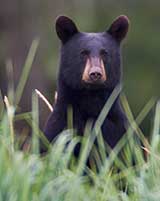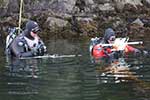Alaska Fish & Wildlife News
November 2016
Prince William Sound Deer Research
Island Deer

One hundred years ago the Cordova Chamber of Commerce arranged to bring Sitka black-tailed deer to Prince William Sound. Eight deer were captured near Sitka in 1916 and transplanted to Hinchinbrook and Hawkins Islands, and an additional 16 were brought in a few years later. This was the first big-game transplant in Alaska, and it was a success. As numbers increased, deer swam to adjacent islands, and today thousands of deer inhabit the islands of Prince William Sound.
State wildlife biologist ... Island Deer Article Continued
The Land Will Always Win
Hunting caribou in the Talkeetna Mountains

At five thousand feet above sea level, the vast terrain of wind-blown rock, craggy grasses and arrogant spires fell under shadow. The sun breached across the western horizon. Following its passing like a wary gang, cloud cover appeared in the east. “It might rain on us tonight,” I said to my wife as she filtered water from a clear stream exhaling from the gut of the earth. We continued to set up camp. Tent staked. Sleeping bags rolled out. Camp stove gasping under the small pot of ... The Land Always Wins Article Continued
Collared Bears Provide Insights

Black bear numbers in Prince William Sound aren’t what they used to be. People who hunt, fish, and photograph wildlife in the area are seeing fewer bears, and they want to know why. This summer, biologists collared 20 black bears with GPS devices to better understand the area’s bears.
“This is a valuable resource on a whole bunch of levels,” said state wildlife biologist Charlotte Westing. “A lot of people are concerned about the resource and we want to learn ... PWS Bears Article Continued
Mapping Invasive Tunicates in Sitka Waters

Alaska marine habitats are biologically rich and extremely varied, from shallow coastal waters to deep sea trenches. People depend on the resources provided by our oceans and coasts for survival and well-being. Globally, marine habitats are under threat by habitat destruction, pollution, and climate change- all driving losses in biodiversity. Some argue invasive species are an equal, if not the greater, threat to marine ecosystems.
Why should we worry about introduced species when many ... Mapping Invasives Article Continued
